
Once introduced, I fell completely in love with reef aquariums and all of their incredible biodiversity. Reef aquariums held an unparalleled appeal due to all of their intricate and interesting levels as an ecosystem. So many elements such as flow, lighting, filtration, aquascaping, and dosing have to come together in just the right way for a reef aquarium to flourish, and for every critter from the smallest amphipod, to the largest colony of coral, to thrive. Reefkeeping was unparalleled until I came to discover what I consider to be reefkeeping’s terrestrial counterpart. Planted dart frog vivariums have the same unmistakable appeal that reefkeeping holds.
I have often sat back and wondered how reef keeping was able to take a solid foothold in North America, while dart frog vivariums lurked in the shadows without ever really finding their way into the limelight. Europe for example has an impressive following for both reef and dart keeping, and it isn’t hard for me to see why. In fact, when it comes to North American hobbyists, many of those who started in reef keeping, but wanted to try something new, have taken to trying dart frogs on for size. There are some striking similarities between the two hobbies, and that is really what I wanted to showcase in this blog. Anything and everything from the equipment involved, the beauty of the inhabitants, to the complexity of the ecosystems themselves.
Before we continue, I use various terms/titles that all mean essentially the same thing, so I will cover those for you now for ease of reading throughout the blog
Reef Aquarium Keeping:
Reefing/Reef Keeping – the act of setting up and caring for a reef aquarium
Reefer/Reefers – An individual(s) who is in the reef aquarium hobby
Dart Frog Vivarium Keeping:
Darting/Dart Keeping – the act of setting up and caring for a dart frog vivarium
Darter/Darters – An individual(s) who is in the dart frog vivarium hobby
Since there is so much ground to cover with comparing these two incredible hobbies, I am going to go ahead and start with some parallels that are visually stunning. Why? Because if you choose not to read through this whole blog, if anything else, I want you to leave with an appreciation for the beauty of dart frog vivariums, and maybe even a little flame of inspiration to express your own creativity by breathing life into one for yourself.

There is no shortage of extravagantly decorated inhabitants when it comes to both reef keeping and dart frog vivariums. In fact, you can find many of the same vibrant metallic hues and intricate patterns across fish and frog species; the coloration of these animals is arguably the largest draw for new hobbyists getting into either of these rewarding branches of vivaria. The breathtaking beauty of saltwater fish is often what draw people into saltwater aquariums and reef keeping. The same can be said for dart frog vivariums; you’d be surprised by how comparable the striking appearance of dart frogs is to reef fishes. Many of the same color combinations and patterns like stripes, spots and swirls can be found across both fish and frog species. For this reason, dart frogs have become more and more popular as eye-catching display animals.
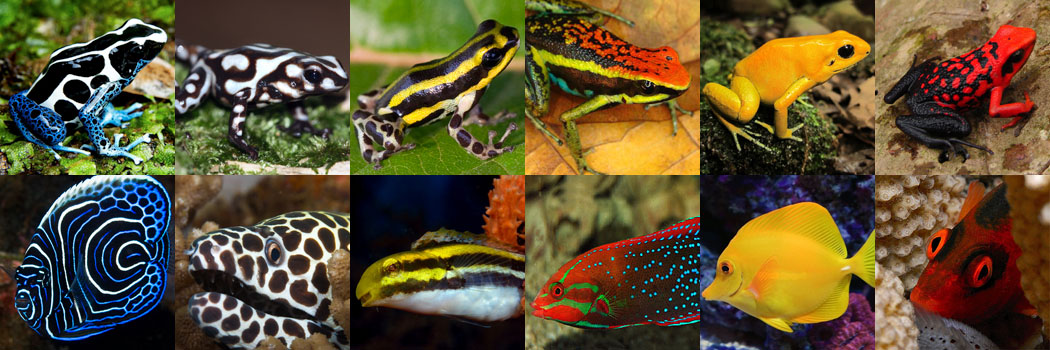

When it comes to comparing Reefing to Darting, this next parallel is arguably the most significant. When you stand in front of a reef aquarium, what you will notice first are the corals. The corals that make up the reef are often the flagship attraction of the aquarium. Sure you may have some incredible and rare fish swimming among the reef, but the pride of a reefer often resides with the corals they have selectively chosen, placed, and cared for long enough for a mature reef to form. With first hand experience, I can confidently say that a dart frog vivarium can be very much the same; with emphasis being placed on the wide variety and colors of the plants chosen, placed, and cared for until a mature jungle is formed. Your frogs will always have their place, and most often will be the front runners when it comes to care and admiration, but the jungle you create for them will be the first thing anyone sees when they stand in front of your vivarium.
Reefers strive for their rockwork to become covered in beautiful purple coralline algae, much in the same way Darters want their wood and background covered in mosses.
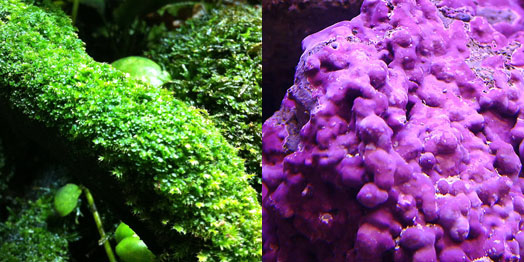
Just like frogs and fish, plants and corals share similarities in color and pattern. Much like corals on a reef, plants not only add shape, texture, and color to a display, but also provide refuge for the inhabitants and aid in the natural cycle of the ecosystem through nutrient uptake.
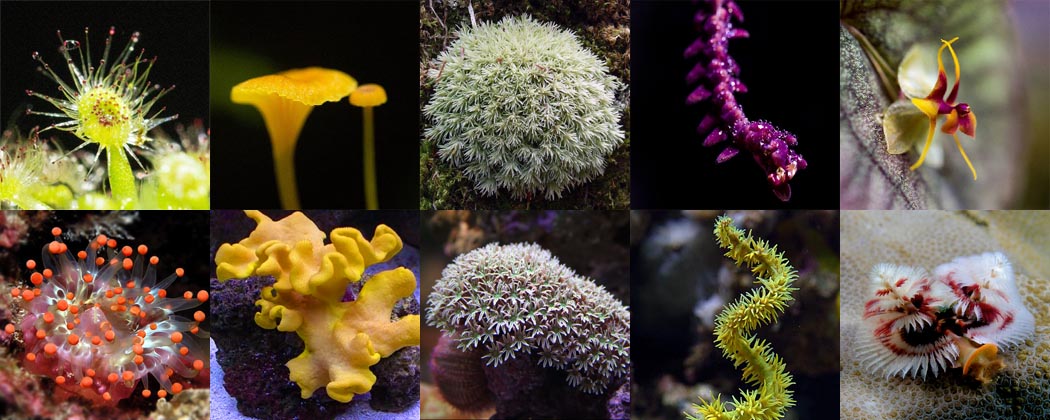
Plants like bromeliads will act as refuge and laying sites for certain species of dart frogs in the same way that corals provide shelter and breeding grounds for many species of reef fish.
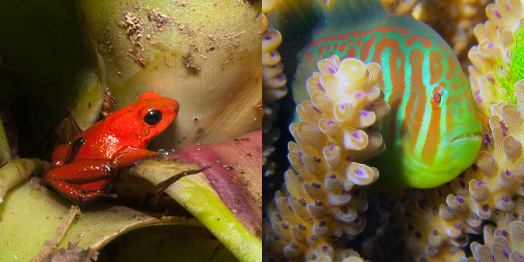
When comparing plants to corals, photosynthesis and the need for proper lighting may seem blatantly obvious, because naturally, it is. However, what most may not realize is that vivarium plants, much like corals, will show their best coloration and growth rates when lighting is optimal. A great example of this is how SPS corals such as Montipora digitata turn brown in low light conditions, or bright purples, greens, or oranges in high light conditions. In a very similar fashion, Bromeliad neoregelia will remain a basic green in lower lighting conditions, or display bright pinks, reds, or purples in high light conditions. As hobbyists, we always strive for the healthiest and most attractive displays; those who enjoy tinkering with lighting to achieve the absolute best from their livestock will find darting eerily similar to reefing in this way.
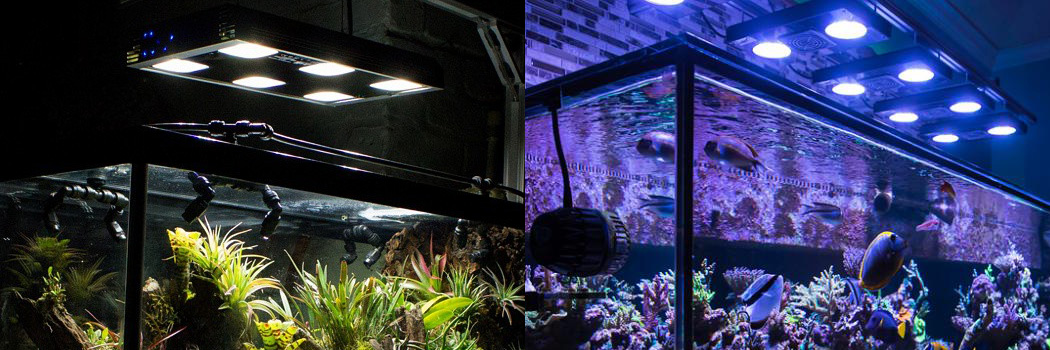
Lastly, before moving on to the next parallel, lets talk about collectability. We aren’t talking about where your plants or corals come from, but rather, the addiction factor that we inevitably fall into with either of these amazing genres of vivaria. Reefers are all too familiar with the obsession of collecting various types of corals, or simply different colors or variations of the same coral, because lets face it, they are fascinating. For example, I know many a reefer with a collection of zoanthids or acanthastrea that could easily be 25 to 50 specimens that are all different from one another. Darters are no different! Orchids, bromeliads, pepperomia, mosses, and more are all highly collectable plants that may even make your average reefer salivate and wish they could keep submersed in their aquarium. Having an extensive collection of eye candy is both rewarding and makes for an interesting and fascinating display.
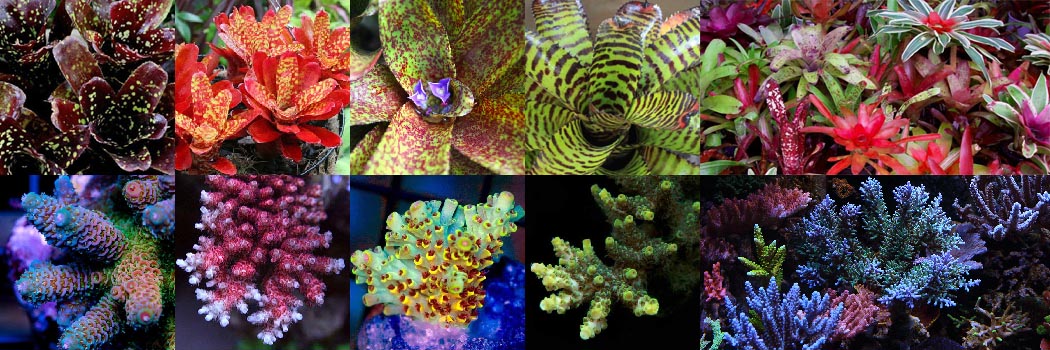
Collectability has lead to demand, and luckily, as talented hobbyists, we manage to create our own supply through great husbandry and propagation techniques. Corals and Plants both grow, and if kept healthy, will either reproduce naturally or can easily be propagated manually through fragmentation. For example, SPS corals are often trimmed, and those trimmed branches are then mounted to small plugs or rocks. These “frags” are often offered to other hobbyists for sale or trade. Plants in the same way are trimmed, or divided, and these clippings, pups, or bulbs are available for sale or trade. You will frequently see “frag packs” or “plant packs” available on local forums or classifieds sites.
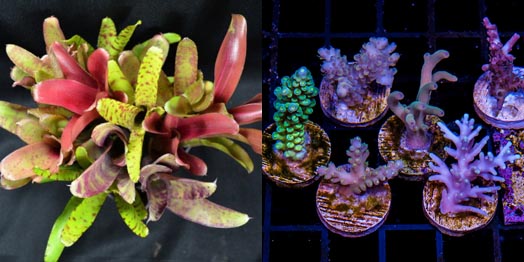

Both a reef aquarium and a dart frog vivarium are types of contained ecosystems, and should be treated as such. If set up properly, both systems can be left completely alone for a period of time and remain self sustained. That isn’t to say that you should expect a hands-off experience, because you will have to actively care for your display, but it is a testament to the remarkable level at which these contained ecosystems can function. For example, when set up properly, both a reef and a dart frog vivarium are capable of consuming or converting waste to prevent a toxic buildup of detritus produced by the inhabitants; an assortment of beneficial bacteria and micro fauna are harbored within the substrate or rock work and consume raw detritus or ammonia and produce less harmful substances which may also be consumed by yet another type of bacteria, plants, or even corals. For reefs, this cycle occurs deep within the pores of the rockwork, while dart frog enclosures act more like compost and manage wastes largely within the substrate layers. Although the processes are carried out differently, the fact is that reefs and dart vivariums share the ability to carry them out.
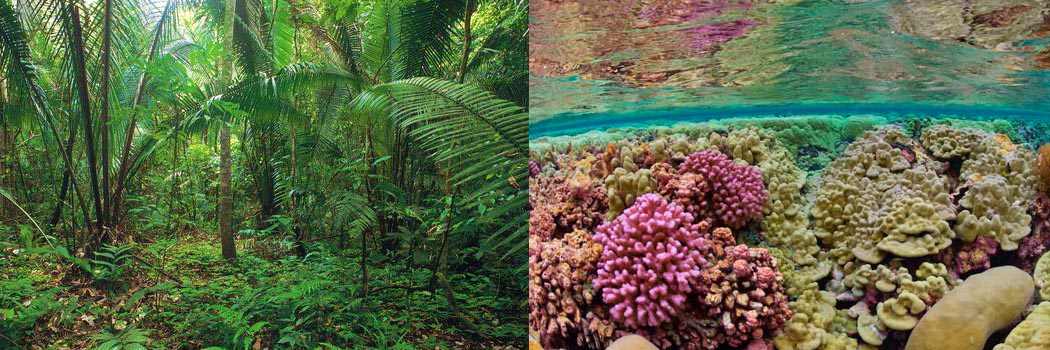
Providing food for the inhabitants is also a function that both of these ecosystems are able to perform. Micro fauna such as copepods and amphipods for a reef, or isopods and springtails for a dart vivarium, can be cultured within the display and continuously provide supplementary feeding that ultimately increases the vitality of frogs and fish alike.
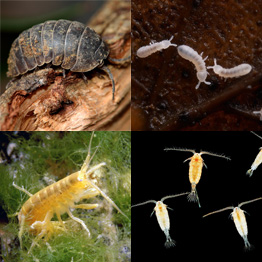
We could certainly get more technical and scientific about this particular parallel, but that on its own could be a whole other blog post, so lets move on.

The modern reef aquarium comes in a wide array of shapes and sizes thanks to various changes in fads over the years from the hex and column tanks of the past, to the modern trends of shallow tanks, cubes, and drop offs. Most of these newer trends lend well to aquascaping, light penetration, or are simply an intriguing new form factor for displaying reef inhabitants. While dart vivariums do have their staples, such as Exo Terra swing door enclosures, the darting community has adopted many of these newer trends, and even come up with a few interesting ideas of their own.
Just a handful of the trends/styles they share:
Large:
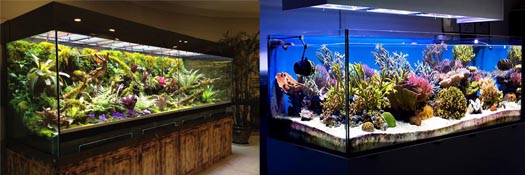
Nano:
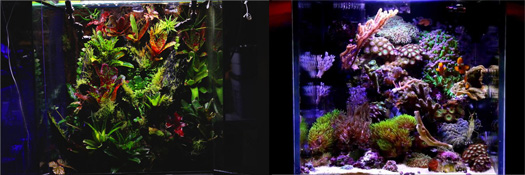
Peninsula :
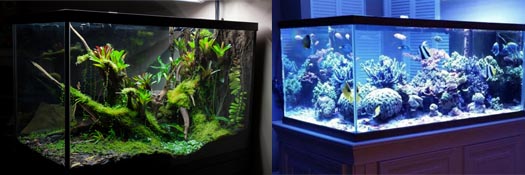
In-Wall:
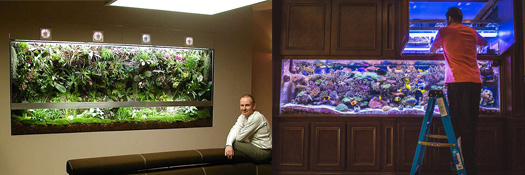
Drop Off:
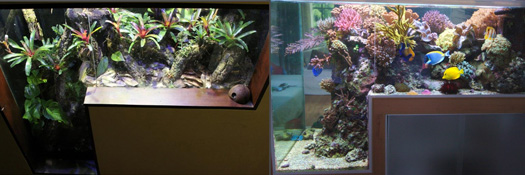

The process of constructing a jungle display follows a very similar path to that of reef aquariums. Your rockwork [aka hardscape] is the foundation of your reef; many of us put an immense amount of effort and attention to detail in the erection of our hardscapes. The choices we make while designing a hardscape will ultimately dictate the overall look and feel of the display. Vivariums are no different in that respect; an interesting and well thought out hardscape can greatly influence the appearance of your vivarium while providing ideal access to light for plants whether potted or pinned.
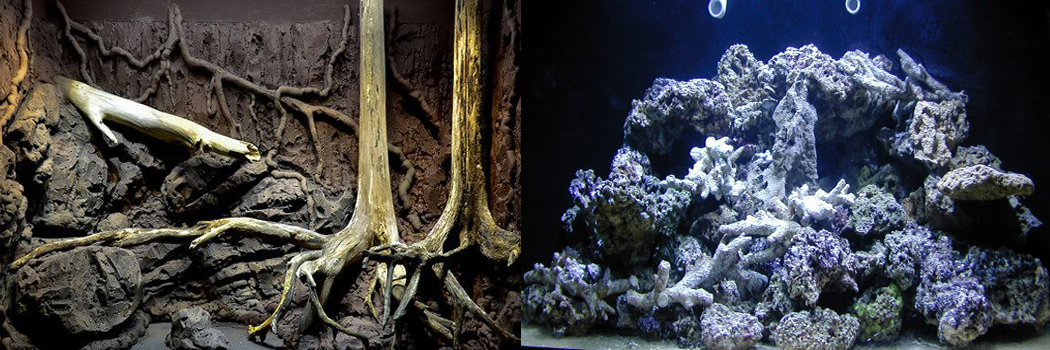
Reefers often create nooks, crannies, and caves with the intent of creating specific locations for corals, clams, and hiding places for fish. Darters do the same by incorporating areas to “pot” plants, driftwood to mount epiphytes, and various concealments to act as shelter for frogs. There are various schools of thought on how the hardscape should be laid out; ultimately it is going to come down to aesthetic preference. Some prefer densely packed displays where every inch of the tank is covered in life; these are what I generally refer to as a “Closed” scape. A closed scape is like taking a picture frame and placing it against a portion of a reef or forest floor. Others prefer an airy scape that has lots of negative space around it; these “Open” scapes are like standing back with a picture frame and looking at a small spot reef, entire tree, stump, or forested area rather than just a small portion of it. It does take some imagination and knowledge of the plants and frogs you intend to keep, but the process is exciting and rewarding whether reefing or darting.
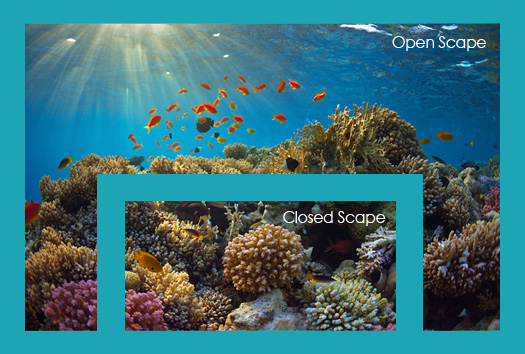

Reef Aquariums and Dart Vivariums even share similarities when it comes to equipment. This is no big surprise when you consider that both are intricate ecosystems that mimic an environment most homes or offices just can not provide without the help of a few [or many] specialized gadgets.
For example, both require high output lighting for proper coloration and growth and often utilizing Power Compact, T5HO, or LEDs. Light fixtures designed for reef tanks are commonly purchased and used overtop of dart vivariums with little change required; a quick swap to the correct spectrum of bulbs or reprogramming of LED color, and you are providing all the light necessary for your plants to thrive. Although, we are finally starting to see some lighting options specifically designed for dart vivariums come into the market. A great example is Jungle Hobbies Advanced LED Lighting System. A ton of high quality LED light with plenty of options to program the perfect schedule and intensity for your particular ecosystem.

Circulation is also quite important; while reef aquariums utilize circulation pumps to provide adequate water flow, dart vivariums make use of small fans to keep the air within the enclosure from becoming stagnant. Currently, there isn’t much in the way of active air circulation products, and dart enthusiasts have been repurposing small computer fans to do the job.
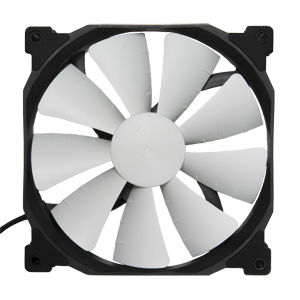
Aquarium pumps and filters are leveraged in dart frog vivariums to power water falls and keep standing pools of water clean. Even sumps can be found commonplace under both reefs and vivariums. While more important for filtration on an aquarium, the sump on a vivarium provides ample water necessary to run water features like waterfalls or trickling walls. Waterfall kits often include a small aquarium utility pump.
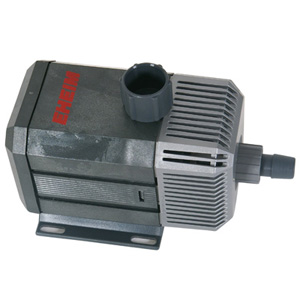
RODI (Reverse Osmosis Deionized) water is ultrapure and crucial for sensitive flora and fauna. Getting a good RODI unit makes a big difference whether you are reefing or darting. Heavy metals, chlorine, chloramines, phosphates, nitrates, and other contaminants can wreak havoc on your ecosystem and can leave unsightly hard water marks, spots, and lime scale on your vivarium glass and foliage. Reefs use RODI for top ups as water evaporates, and water changes. Dart vivariums require RODI water for misting and watering plants, frogs, and tadpoles.
Controllers are commonplace in reefing, and have already started trickling into the dart frog world. Controllers are designed to help automate certain tasks, as well as monitor and document various essential parameters. Tasks such as monitoring and maintaining RH [humidity], monitoring and maintaining temperature, and acting as a timer for your lighting system are staple functions for many controllers. Automating these tasks helps to increase the stability of your ecosystem, which will also help keep your inhabitants in optimal health. Thankfully we are starting to see more and more progress in this category for the dart frog hobby; Digital Aquatics has a fantastic controller called HerpKeeper, and it allows for all the functions I have mentioned here, and more. For controllers that are more simple in function, look at the new line of controllers by MistKing!

Another parallel between reefing and darting is the opportunity for DIY [Do It Yourself] projects. DIY is incredibly commonplace in reef keeping for a number of reasons; some hobbyists simply can not afford or would rather not spend the money on high end equipment, and instead make something similar on their own that is going to do the same job. Sometimes there just isn’t a product on the market yet that fits the needs of your system, and rather than waiting around for someone else to execute the idea, you make your own prototype and put it to work. For many, DIY is way of making your project more personalized and ultimately unique; DIY has become a fun and engaging part of being a reefer. What some may not realize, is that DIY is also a very useful practice for darting. Dart vivariums, although gaining traction, are still in the infancy of their popularity in North America. Many companies have started making products to fill the gaps in this niche hobby, but there are still many more gaps to be filled. This means, for now, DIY is one of the best tools you can have in your arsenal. Below is a rotted stump crafted using various pieces of Malaysian driftwood, egg crate, expanding foam, silicon, Hygrolon, and peat moss.
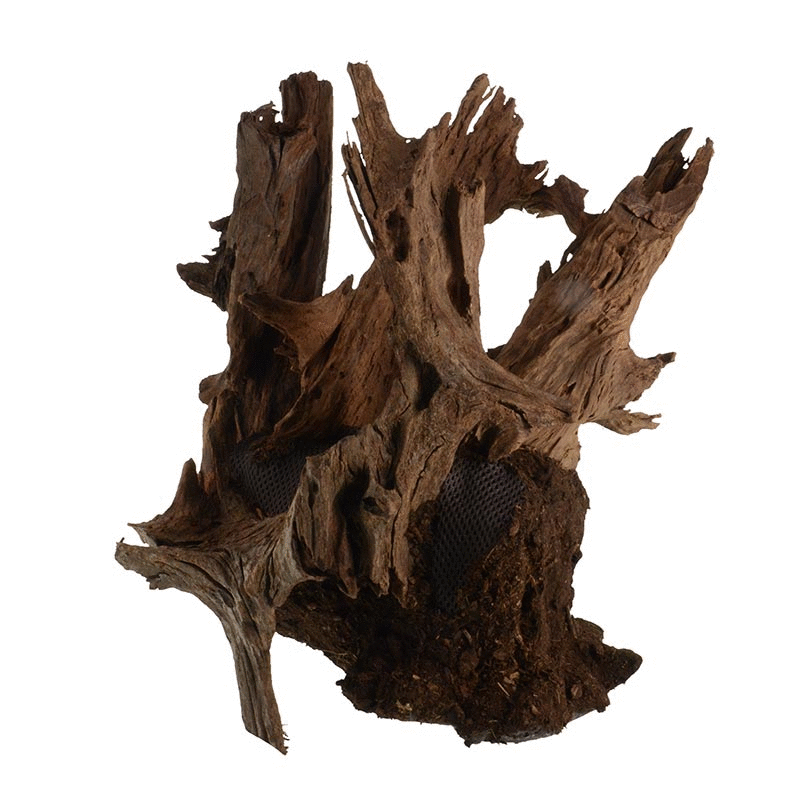
The desire to hide your equipment is also worth mentioning; a display cluttered with equipment, however necessary it may be, is unsightly no matter how you look at it. Reefers and darters alike have been finding ways to minimize the visibility of equipment. We all strive for clean, attractive displays with high functionality, and products have come to market that help us keep things tidy, camouflaged, and otherwise out of sight. Reefers definitely have the advantage here, while darters are still relying heavily on DIY. As the dart frog vivarium hobby progresses, we are bound to see more and more useful, innovative, and exciting products hit the market; a great example of such a product is the Biopod.
Biopod is a recent Kickstarter project by founder Jared Wolfe that brings an incredible amount of functionality into an incredibly compact and clean looking product. Everything from lighting, heating, and misting, to WIFI connectivity and an HD Camera has been packed into a very attractive and well thought out enclosure that can communicate with your smart devices and replicate complex natural habitats at the touch of a button. It is hard to imagine all that functionality without a mess of equipment surrounding the enclosure, but Biopod has pulled it off.
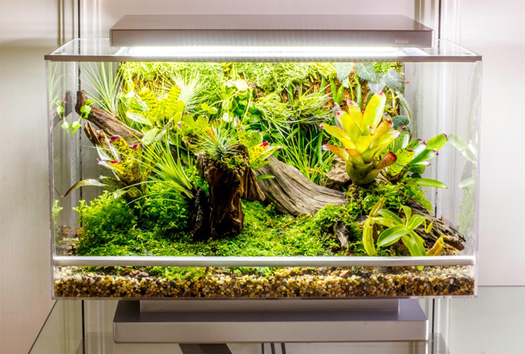
Before we move on from the discussion of equipment, lets touch on the design intricacies of reefing and darting. Those familiar with reefing know that there is an unlimited number of ways you can build your system. From the type of filtration, plumbing, lighting, skimmers, to the type of rock, corals, and fish you want to keep, your system is going to be distinctive to your taste and preferences. Darting is no different; you can build your system from the ground up to fit your needs exactly. Whether you want to use expanding foam or clay to create a custom background, or use a standard aquarium rather than a specialized reptile terrarium, at the end of the day, no matter how approach the design and build of your dart vivarium, always consider the frogs first. What species you decide to keep will dictate the overall design requirements of your build. Some frogs may need more vertical space, some may need it to be drier, some may want to use plants for lay sites, some may not climb much at all and require a lot of floor space, some are shy and need a lot of cover. Putting your frogs and plants first is the first step to success when designing an enclosure, much in the same way putting your fish and corals first is paramount to your success with a reef aquarium.

Now, reefs and dart vivariums do have their differences and I will touch on them briefly simply to show both sides of the coin, and make sure that you, the reader, leave with a rounded understanding of what is involved with darting.
Firstly, lets discuss some of the positive differences, such as the amount of effort it takes for long term success with a dart frog vivarium can be dramatically less than that required for a reef aquarium. The need to maintain perfect water chemistry through constant monitoring of levels, actively dosing, and doing water changes as needed adds quite a bit of extra effort to reefkeeping. Darters need not worry about ‘air changes’ or the constant monitoring of the air’s chemical makeup.
Plants are far more resilient than corals in most cases. They grow much faster than corals, meaning your display will look fuller, and more mature, faster than any reef aquarium. They also tend to be more forgiving to changes in their environment, responding slower to maladies, and recovering faster when given ideal conditions.

Vacationing is much easier with a dart vivarium. Reef aquariums are often hard to step away from for a week or two without having a family member or neighbor stop in once or twice a week to check up on the aquarium, feed the fish, top up the tank from evaporation, and ultimately make sure that all is well with the system. Yes, there are various ways to automate the aquarium to eliminate some of these jobs (i.e. ATO devices, automatic feeders, aquarium controllers with email or text notifications) but that can cost thousands of dollars and you may still have equipment malfunction that can lead to a catastrophic tank crash (massive die off of aquarium inhabitants) unless you are immediately available to remedy the situation. Dart vivariums can usually go an easy 2 weeks without any human intervention provided the lighting is on a timer, the misting is automated, and the vivarium is established correctly to provide food for the frogs via spring tails and/or isopods. Unlike reefs, dart vivariums do not ‘crash’ in the same way reefs can; vivarium decline can take weeks to months rather than hours. The only exception is with dramatic and prolonged temperature fluctuations that may be fatal for the frogs and plants.
Breeding dart frogs is easier than breeding marine fish. Dart frogs, if kept healthy, will often breed without too much effort; although this can also be true for some marine species, what makes dart frogs easier to breed successfully is the simplicity of caring for their tadpoles. Most marine fish go through a planktonic larval stage where they are almost impossible for the average reefer to care for or feed adequately; requiring live planktonic foods such rotifers that must be cultured regularly. This takes time, resources, fineness, and a lot of dedication. Many have described rearing the fry of marine fish as a full time job. Tadpoles on the other hand are quite forgiving and simply need to be separated into containers and fed fish flake food in order to thrive. After a time they begin to morph, and then crawl out fully formed frogs ready to be treated as such. Some dart frog species will actually need to raise their tadpoles on their own, and the hands off experience is amazing to watch and will leave you with a true appreciation for the natural behaviors of dart frogs.
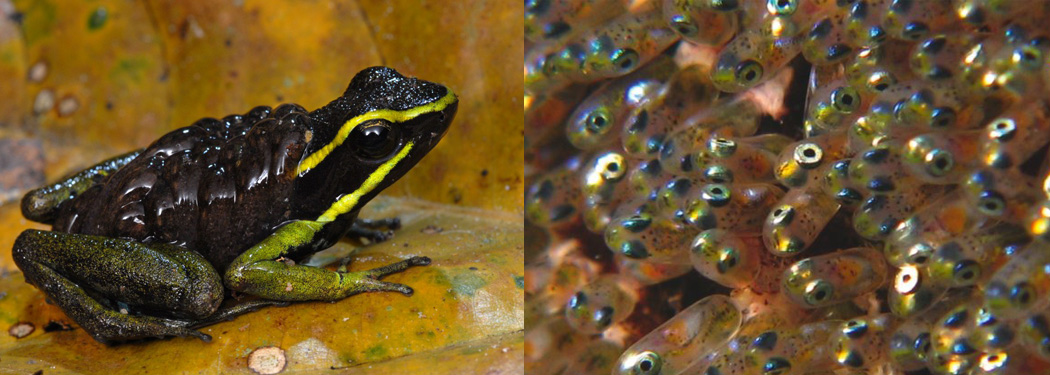
For these reasons, the average person is more likely to find success with their first dart vivarium than with their first reef, which is quite encouraging! Not to mention that the average dart vivarium is going to cost much less to set up than the average reef aquarium of similar size.
To be fair, here are some of the potentially negative differences that may make you second guess setting up a dart frog vivarium. For example, dart frogs only eat live foods; most commonly fruit flies. This means that unlike reef aquariums where you can store prepared foods long term and easily feed whenever you want, you will need to make the culturing (or regular purchase) of fruit flies a part of your pet regime. Fear not, the fruit fly cultures that are commonly used for feeding dart frogs are ‘flightless’ and the flies have modified wings that are useless for flight, so there shouldn’t be any flies buzzing around your home.
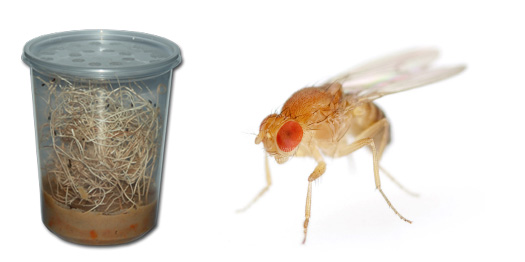
While reef aquariums often house a wide and fantastical array of different and interesting fish species in a single display, it is considered taboo to mix dart frog species, subspecies, or even locals of the same species/subspecies in a single enclosure. This may seem limiting, and it certainly is, but it is for the greater good of the hobby. Darters strive to prevent hybridization and prefer to keep the frogs as true to their natural form as possible. The best way to do that is to prevent accidental cross breeding by housing frog species/subs/locals separately. It is also worth mentioning that the mixing of species/subs/locals can also change the way the frogs behave, and could prevent them from displaying their natural, incredibly interesting, and entertaining social habits.
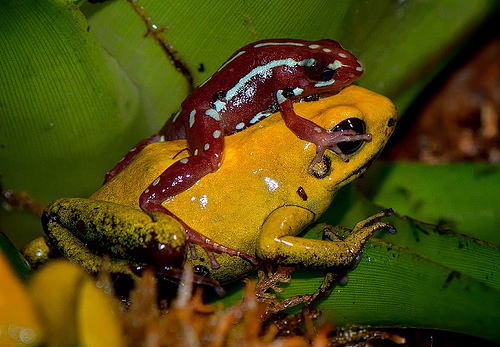
Currently, the reef aquarium hobby has a lot more high-end products to help make reefing easier, and ultimately, is more evolved as a hobby in North America. Unfortunately for us darters, that means we have to work a little harder and be more creative in the DIY department. For a lot of us out there, this is all part of the fun, but for others, this may seem like a hurdle that isn’t worth jumping over. Thankfully companies like Jungle Hobbies, Biopod, and Digital Aquatics are helping turn the tide for dart frog enthusiasts; as time goes on and the popularity of dart frog vivariums grows, we will see more and more innovative products hit the market.

There are clearly a lot of parallels that can be drawn between both darting and reefing that ultimately describes why reefers and darters appreciate these incredibly interesting branches of vivaria, and even a handful of differences. At the end of the day what I hope you, the reader, takes home from this blog is an appreciation for the beauty and intricacies of both darting and reefing. For the existing reefers out there that may be looking for something new and exciting, I hope you are inspired. If you have any questions or comments, please feel free to leave them here, reach out to us on facebook or Twitter, or contact Natural Aquaria at info@naturalaquaria.com
Special Thanks to:
Dave B. – for introducing me to dart frogs many moons ago; this blog would not exist if not for your love of the hobby.
Matt W. – for being my second set of eyes when proofreading this lengthy blog.
Brian [Giga] – Drop Off Vivarium Photo
Jared W. [Biopod] – Biopod Photo
Josh Moore – Vivarium Hardscape Photo
Justin Grimm – Peninsula Vivarium Photo
Inka4040 – Moss Covered Photo
Gady-Gady – In-Wall Vivarium Photo
Google Image Search – Various Photos

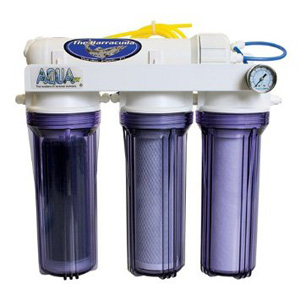






[…] Frog Vivariums Vs. Reef Aquariums Just finished this blog post last night! Compares reefing to dart keeping and has a ton of visuals to boot! Hope you folks enjoy it! Natural Aquaria […]
Even though I stumbled upon this article, I found it very fascinating and worth the read. Very good use of pictures to back up the comparisons you are making. I’d like to see more articles written like this. Good job.
Thank you, Matt!